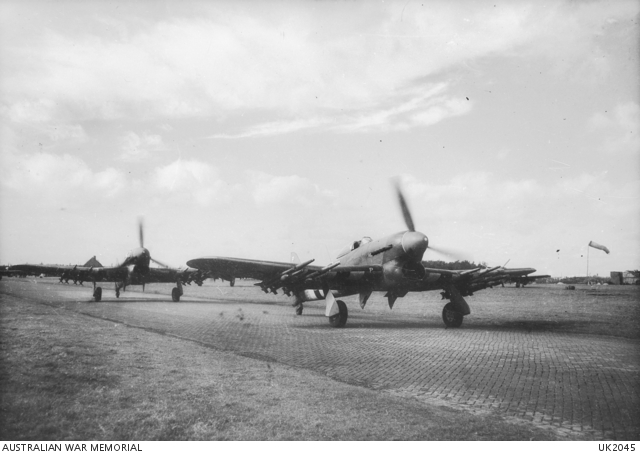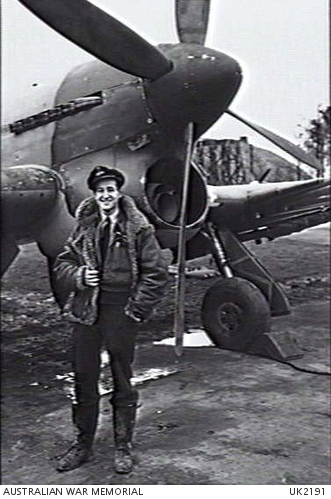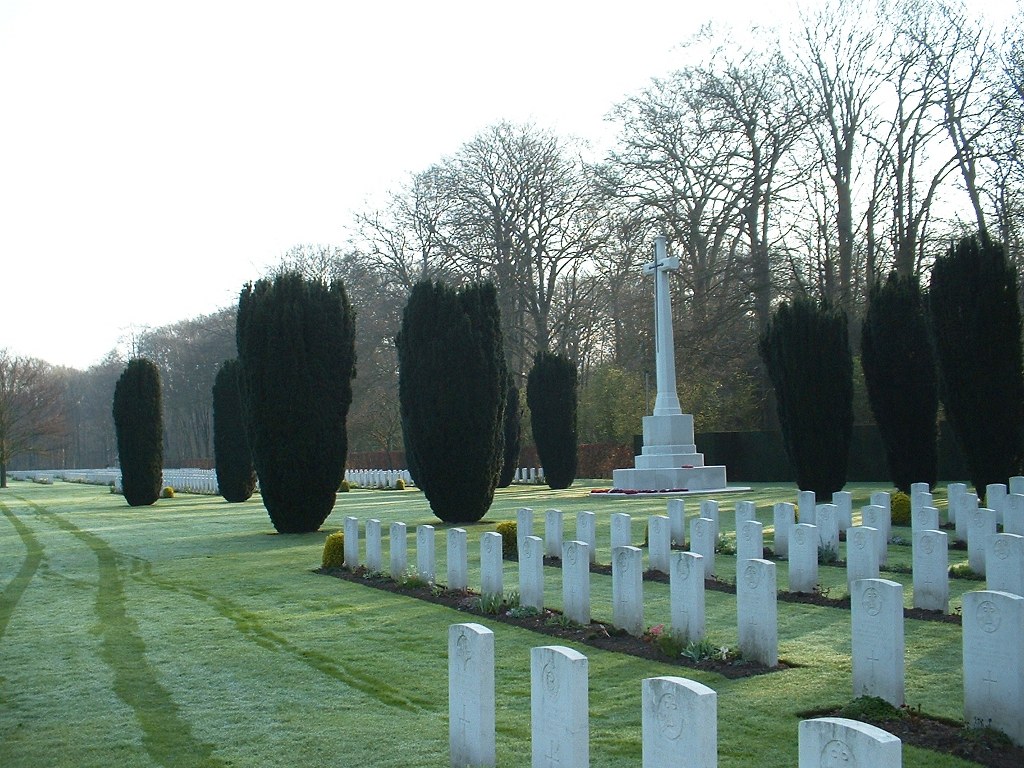Flight Sergeant Raymond Kennedy Gibson, the son of Raymond Stanley Gibson and Janet Ivie Gibson (nee Allen), was born at Brisbane in Queensland on 14th November 1920. He enlisted in the Reserve of the Royal Australian Air Force on 2nd June 1941 after swearing the statutory oath of allegiance. He was issued with Reserve Badge No. 9202. At the age of 20 years and 10 months he was enlisted into the Citizen Air Force of the R.A.A.F. at No. 3 Recruiting Centre in Brisbane on 11th October 1941 as a trainee pilot after giving an undertaking that he would serve for the duration of the war and an additional twelve months. At the time of his enlistment, he was single and employed as a Clerk with Liverpool, London & Globe Insurance Company in Toowoomba. He stated that he was of the Presbyterian religion. His physical description was that he was five feet nine inches in height and weighed 126 pounds. He had a fair complexion, blue eyes and brown hair. He gave his next of kin as his father, Mr Raymond Stanley Gibson, residing at 135 West Street in Toowoomba.
Flight Lieutenant Raymond Gibson was allotted the service number of 414482. He joined No. 3 Initial Training School at Amberley on 11th October 1941 where he was trained in military discipline and the basics of military aviation. He then joined No. 2 Elementary Flying Training School at Archerfield in Queensland on 4th February 1942 where he received instruction on basic single-engined trainer aircraft. He joined No. 5 Elementary Flying Training School at Narromine in New South Wales on 17th April 1942. He joined No. 7 Service Flying Training School at Deniliquin in New South Wales on 3rd May 1942. After completing his training at Deniliquin he was awarded the Pilot Qualification Badge on 23rd June 1942. He was appointed to the commissioned rank of Pilot Officer of 15th October 1942.
Flight Lieutenant Raymond Gibson joined No. 3 Embarkation Depot at Sandgate in Queensland on 16th October 1942 where he proceeded on pre-embarkation Leave. He joined No. 2 Embarkation Depot at Bradfield Park in New South Wales on 1st November 1942 to prepare for movement overseas. He embarked from Sydney in New South Wales on the ship “Port Darwin” on 10th November 1942 for overseas service on attachment to the Royal Air Force. After arriving in the United Kingdom he joined No. 11 Personnel Despatch & Reception Centre at Bournemouth on 4th May 1943. He is also shown on that day as joining No. 17 Advanced Flying Unit at Royal Air Force Station Watton. He joined No. 56 Operational Training Unit at Royal Air Force Station Milfield on 29th June 1943 where he trained on Typhoon/Tempest aircraft. He joined No. 609 (West Riding) Squadron Royal Air Force at Royal Air Force Station Duxford on 24th December 1943. Whilst serving with his squadron he was promoted to the rank of Flight Lieutenant on 15th October 1944. He attended a course of instruction at the Fighter Training School at Royal Air Force Station Milfield during the period 8th August until 22nd December 1944. The unit specialized in training officers in commanding ground attack units, with a focus on the skills which would be needed to lead close support operations from front-line airfields in Europe. He joined No. 609 (West Riding) Squadron Royal Air Force at Royal Air Force Station in the Netherlands on 24th December 1944.
A temporary cross was placed on Raymond Gibson’s grave after his remains were exhumed and reburied in the Reichswald Forest War Cemetery. Flight Lieutenant Raymond Gibson was the pilot of a No. 609 (West Riding) Squadron Royal Air Force Typhoon Fighter Bomber IB RB 311 who lost his life at Geoch, Germany, on 14th February 1945 whilst attacking a target at Cleve Forest near Emmerich in Germany. The Air Ministry advised his mother, residing at 135 West Street, Toowoomba, that he was missing on air operations. At the time of his death Raymond Gibson was 24 years of age. After the war when his aircraft and his body were located, his remains were exhumed and laid to rest in the Reichswald Forest War Cemetery in Germany. Raymond Gibson’s headstone in this cemetery contains the family inscription “To Live In The Hearts Of Those We Love Is Not To Die”.
The Commanding Officer of Raymond Gibson’s squadron wrote the following letter to his mother on the day after his aircraft crashed:
Dear Mrs Gibson, You will by now have received news that your son Raymond was reported missing from operations yesterday the 14th February 1945, and it is with deep sorrow that I now write to give you what information I can. Raymond was leading a section of four aircraft detailed to attack an enemy strongpoint in the front line. Whilst in the target area flak was encountered and Raymond’s machine was seen to be hit. The machine immediately spun down and hit the ground in flames. This must be a terrible shock to you Mrs Gibson, and I cannot express in words what a fearful loss it is to the squadron. Your son was a very brave man and his fellow pilots are deeply sorry to lose in him one of the best pilots in the squadron, and a good friend to all of us. In cases like these there is always a hope that Raymond might have got clear but I do not wish to raise false hopes. As soon as more information comes to hand I will write to you immediately, in the meantime please accept my deep sympathy in this anxious time. Yours sincerely, Squadron Leader Roberts.
Investigations carried out by Flying Officer H. Keen of the Missing Research & Enquiry Service after the war resulted in the following report being submitted:
As instructed I made a search of the area north-east of Goch. German records showed a crash at Pfalzdorf, 5 miles north-east of Goch. I accordingly proceeded to the scene of this crash with the following results: – Aircraft – this proved to be the remains of a badly smashed and burned Typhoon. The attitude of the engine suggested that the aircraft had struck the ground with considerable force whilst in a fairly steep dive. With the aid of a farm labourer and the loan of his horse, I excavated the engine. The volute casing was completely destroyed by fire. Washing of the starboard upper cylinder block, however, revealed the numbers 4173S in red paint. These being the last four figures of the engine number. The letter S standing for starboard. The numbers PR2695 and N674 were discovered on the rear of the block. The port and starboard cannons were discovered intact with the trailing edge of the mainplane. Thus was the identity of the aircraft established.
Crew – The pilot was buried immediately beside the aircraft. He had remained in the aircraft from the date of the crash until 11th March 1945, when he was buried by allied soldiers. Interrogation of Farmer Jakob Hane upon whose land the aircraft crashed, was the only discoverable witness of the incident. He confirmed the information, contained in the Burgermaster’s records, that the crash occurred on the 14th February 1945 and estimated the time at approximately 1000 hours. He first saw the aircraft after it had passed over his house. It was in flames and diving steeply. It exploded on hitting the ground and continued to burn. No parachute was seen by him, and being apparently reluctant to examine the aircraft, saw no body. He was not able to supply concrete information as to who buried the body, as on the 16th February 1945 he quit his home, but stated that he heard that the pilot was buried by Allies some time later. The Burgermaster of Pfalzdorf stated that considerable confusion existed in Pfalzdorf owing to the close proximity of the Allies. This accounts for the fact that the body remained in the aircraft until buried by the Allies a month later.
Exhumation of the body buried beside the aircraft revealed a few bones in a condition consistent with that of the aircraft i.e., badly burned. A few burned scraps of the officer’s shirt were discovered however, and several small pieces of Mae West webbing. I consider that as the aircraft has been positively identified and that it is well established that the body came from the aircraft by the presence of the scraps of shirt and webbing, the body is that of Flight Lieutenant Gibson and further investigation in this case is unnecessary.
Raymond Gibson was recommended for the award of a Distinguished Flying Cross. His award of the Distinguished Flying Cross was gazetted on 13th February 1946. The citation for the award of the Distinguished Flying Cross stated the following:
Flight Lieutenant Gibson has taken part in a large number of varied operations which have included attacks on canals, headquarters and dumps, gun positions and bridges. Immediately prior to D-Day, Flight Lieutenant Gibson took part in a number of successful attacks on heavily defended installations, and throughout the campaign destroyed and damaged enemy transport and tanks. In September, 1944 he took part in operations against gun positions in the Calais area, inflicting severe damage in the face of heavy opposition. Flight Lieutenant Gibson has proved to be a fearless pilot and flight commander.

Australian War Memorial Photograph: UK2045
Typhoon Ground Attack Aircraft Taxiing to runway.
The following newspaper report was published in the Goulburn Evening Post on Wednesday, 7th February 1945:
THE R.A.A.F. OVER EUROPE – AUSTRALIANS ARE FOUND IN EVERY FIELD. (By Cable from London). Flight Lieutenant Raymond Kennedy Gibson, 24, of Toowoomba, has been appointed a Flight Commander in the famous West Riding Squadron – part of a rocket firing Typhoon wing with the Second Tactical Air Force in Holland. He joined up three and a half years ago when his brother, a Sergeant Major with the Australian Army Medical Corps, was taken prisoner by the Japs in Thailand. Gibson, whose mother lives in West Street, Toowoomba, is engaged to Miss Alison Juener, Stephens Street, Annerley, Brisbane.
Trained in Queensland and New South Wales, Gibson came to Britain in October, 1942 and has always flown Typhoons on operations. He has been with this wing since the meteoric advance from Caen and the Falaise Gap, and has been on nearly every operation with the West Riding Squadron. Destroying tanks, radar stations, oil stores and motor transport vehicles is their main task. He has been hit by flak more than once, and sometimes returned with gaping holes in the fuselage, but never yet had to bail out. Gibson also took part in the difficult long-range operations north of the river Maas, and in the Hertogenbosch area. Educated at the Toowoomba Grammar School, he was with the Liverpool, London and Globe Insurance Company in Brisbane and Toowoomba. He was runner-up for two years in the Toowoomba Golf Championship, and played cricket for the Grammar School. “We’re a games-loving family,” Gibson said. “Dad, who died four months after I was over here, was a well-known golfer in Toowoomba and Brisbane. Mother was a croquet champion in Queensland for three years running. I played a lot of golf when I was training in Scotland. I’d like folks at Queensland to know about the marvellous hospitality I’ve enjoyed. I spend all my leave at a wonderful farm at Pewsey, near Devizes, Wiltshire, as a guest of Mr O.M. Peall, where I ride, shoot and fish”.
Raymond Gibson’s name is commemorated on Panel No. 122 at the Australian War Memorial in Canberra and locally on the Toowoomba Grammar School World War 2 Honour Board. For his service during World War 2, he had entitlement for the Pilot Qualification Badge, the 1939/1945 Star, the Aircrew Europe Star, the Defence Medal, the War Medal and the Australian Service Medal 1939/1945.
Toowoomba Grammar School archive records show that he enrolled as a day student on 29th January 1936 and that he left the School on 6th December 1938 when he passed six subjects in the Junior examination. His parent was shown as Mr Raymond Stanley Gibson, 67 West Street, Toowoomba. Whilst at the school he participated in cricket.




